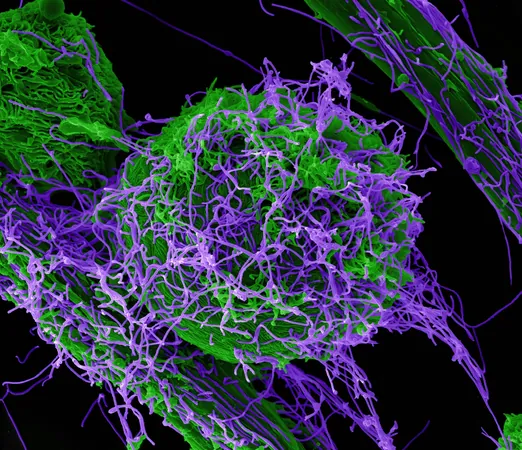
New Research Reveals How Ebola Virus Surfaces on Skin: A Game Changer in Understanding Transmission
2025-01-01
Author: Sarah
Introduction
Ebola, a notoriously lethal hemorrhagic disease, is primarily known for its devastating outbreaks in East-Central and West Africa. While many understand that the virus spreads through direct contact with the bodily fluids of infected individuals, startling new research reveals an underexplored transmission route: the skin surface of infected individuals.
Key Findings
Recent studies, including the harrowing 2013-2016 Ebola epidemic, unearthed evidence that infectious Ebola virus (EBOV) lingers on the skin's surface, especially in the later stages of the disease or after death. However, the mechanism behind how EBOV escapes from the body to invade the skin remains largely a mystery—until now.
Study Overview
A groundbreaking study conducted by researchers at the University of Iowa Health Care, in collaboration with Texas Biomedical Research Institute and Boston University, has meticulously traced the cellular pathway that EBOV follows to breach both the inner and outer layers of skin.
Research Methodology
Published in *Science Advances*, this pivotal study identifies specific cell types within the skin targeted by EBOV during infection, demonstrating that human skin can actively support EBOV proliferation. Dr. Wendy Maury, a microbiology and immunology professor, emphasized, “The skin is the largest organ in the human body yet is woefully understudied compared to others. Our findings open the door for a more comprehensive understanding of EBOV’s interaction with skin cells.”
Innovative Approach
The researchers utilized a novel human skin explant model—crafting full-thickness skin biopsies that retain both the dermal and epidermal layers. By introducing the virus from underneath these explants, they simulated how EBOV might escape the bloodstream to reach the skin’s surface. This method allows scientists to track the virus's elusive journey through various skin layers and identify which cells get infected over time.
Cellular Interaction
Interestingly, the research confirmed that EBOV infiltrates numerous cell types in the skin, including macrophages, endothelial cells, fibroblasts, and keratinocytes. Notably, while cells in other organs also show susceptibility to EBOV, keratinocytes—skin cells pivotal for barrier function—had not previously been recognized as potential hosts for the virus. This new insight is crucial; if keratinocytes can support EBOV, it could change how we view risks associated with handling infected individuals.
Transmission Implications
Remarkably, the study found that EBOV replicates more vigorously in the epidermis compared to the dermis, with infectious virus present on the skin surface in just three days, underscoring a faster transmission risk than previously envisaged. This rapid spread from the skin’s lower layers presents a concerning possibility for person-to-person transmission, reinforcing the importance of hygiene and precautionary measures during outbreaks.
Future Research Directions
Additionally, the researchers demonstrated that these human skin explants can serve as sophisticated three-dimensional models for antiviral research, which may pave the way for future therapeutic advancements in combating Ebola and potentially other viral infections.
Conclusion and Implications
The authors delved deeper into the interactions between EBOV and specific skin cell types—particularly fibroblasts and keratinocytes—highlighting receptors involved in the virus's entry into these cells. Understanding these interactions could be pivotal for the development of targeted antiviral therapies.
As the researchers continue their investigation into EBOV's behavior in skin, the implications of this study are profound. It not only sheds light on an overlooked transmission route but also propels the scientific community closer to pivotal advancements in treatment methodologies. The stakes remain high, and with this revolutionary study, we might just be on the cusp of a breakthrough that could save countless lives during future outbreaks.

 Brasil (PT)
Brasil (PT)
 Canada (EN)
Canada (EN)
 Chile (ES)
Chile (ES)
 Česko (CS)
Česko (CS)
 대한민국 (KO)
대한민국 (KO)
 España (ES)
España (ES)
 France (FR)
France (FR)
 Hong Kong (EN)
Hong Kong (EN)
 Italia (IT)
Italia (IT)
 日本 (JA)
日本 (JA)
 Magyarország (HU)
Magyarország (HU)
 Norge (NO)
Norge (NO)
 Polska (PL)
Polska (PL)
 Schweiz (DE)
Schweiz (DE)
 Singapore (EN)
Singapore (EN)
 Sverige (SV)
Sverige (SV)
 Suomi (FI)
Suomi (FI)
 Türkiye (TR)
Türkiye (TR)
 الإمارات العربية المتحدة (AR)
الإمارات العربية المتحدة (AR)